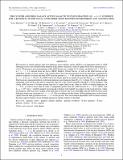THE CLUSTER AND FIELD GALAXY ACTIVE GALACTIC NUCLEUS FRACTION AT
Author(s)
Martini, Paul; Brodwin, M.; Stanford, S. A.; Gonzalez, Anthony H.; Bautz, Marshall W.; Hickox, R. C.; Stern, D.; Eisenhardt, P. R.; Galametz, A.; Norman, D.; Jannuzi, Buell T.; Dey, A.; Murray, S.; Jones, C.; Brown, M. J. I.; Miller, Eric D; ... Show more Show less
DownloadMartini-2013-THE CLUSTER AND FIEL.pdf (1.046Mb)
PUBLISHER_POLICY
Publisher Policy
Article is made available in accordance with the publisher's policy and may be subject to US copyright law. Please refer to the publisher's site for terms of use.
Terms of use
Metadata
Show full item recordAbstract
The fraction of cluster galaxies that host luminous active galactic nuclei (AGNs) is an important probe of AGN fueling processes, the cold interstellar medium at the centers of galaxies, and how tightly black holes and galaxies co-evolve. We present a new measurement of the AGN fraction in a sample of 13 clusters of galaxies (M ≥ 1014 M ☉) at 1 < z < 1.5 selected from the Spitzer/IRAC Shallow Cluster Survey, as well as the field fraction in the immediate vicinity of these clusters, and combine these data with measurements from the literature to quantify the relative evolution of cluster and field AGN from the present to z ~ 3. We estimate that the cluster AGN fraction at 1 < z < 1.5 is f[subscript A] = 3.0[+2.4 over -1.4] % for AGNs with a rest-frame, hard X-ray luminosity greater than L X, H ≥ 10[superscript 44] erg s[superscript –1]. This fraction is measured relative to all cluster galaxies more luminous than M[* over 3.6] (z) +1, where M[* over 3.6] is the absolute magnitude of the break in the galaxy luminosity function at the cluster redshift in the IRAC 3.6 μm bandpass. The cluster AGN fraction is 30 times greater than the 3σ upper limit on the value for AGNs of similar luminosity at z ~ 0.25, as well as more than an order of magnitude greater than the AGN fraction at z ~ 0.75. AGNs with L X, H ≥ 10[superscript 43] erg s[superscript –1] exhibit similarly pronounced evolution with redshift. In contrast to the local universe, where the luminous AGN fraction is higher in the field than in clusters, the X-ray and MIR-selected AGN fractions in the field and clusters are consistent at 1 < z < 1.5. This is evidence that the cluster AGN population has evolved more rapidly than the field population from z ~ 1.5 to the present. This environment-dependent AGN evolution mimics the more rapid evolution of star-forming galaxies in clusters relative to the field.
Date issued
2013-05Department
MIT Kavli Institute for Astrophysics and Space ResearchJournal
Astrophysical Journal
Publisher
Institute of Physics/American Astronomical Society
Citation
Martini, Paul, E. D. Miller, M. Brodwin, S. A. Stanford, Anthony H. Gonzalez, M. Bautz, R. C. Hickox, et al. “ THE CLUSTER AND FIELD GALAXY ACTIVE GALACTIC NUCLEUS FRACTION AT z = 1-1.5: EVIDENCE FOR A REVERSAL OF THE LOCAL ANTICORRELATION BETWEEN ENVIRONMENT AND AGN FRACTION .” The Astrophysical Journal 768, no. 1 (April 8, 2013): 1. © 2013 American Astronomical Society.
Version: Final published version
ISSN
0004-637X
1538-4357